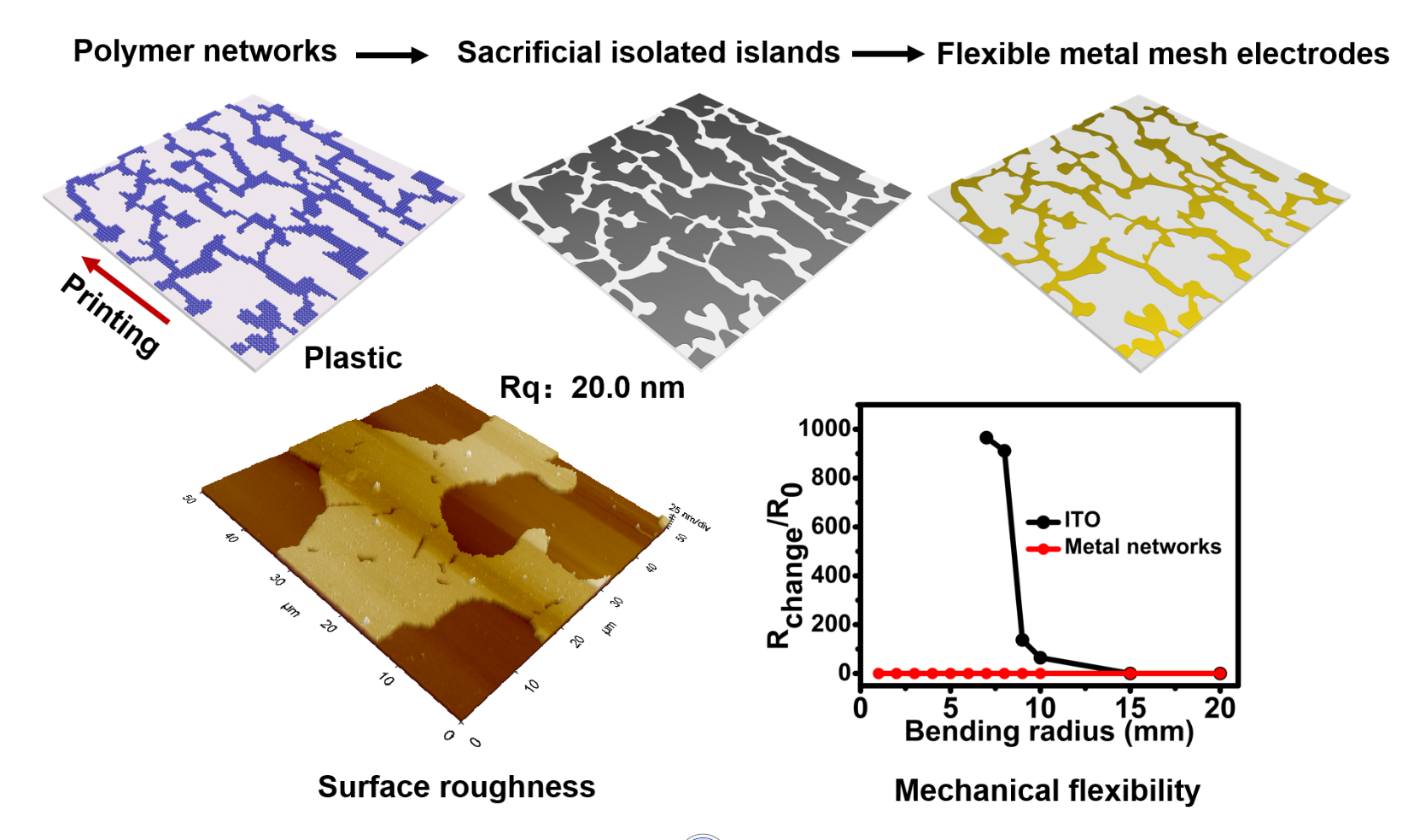Juan, Xiaodong, and Ting’s Paper in ACS Applied Materials and Interfaces. Congrats!!
Paper title: Highly Flexible Transparent Micromesh Electrodes via Blade-Coated Polymer Networks for Organic Light-Emitting Diodes
Abstract: The availability of transparent conductive thin films that exhibit mechanical flexibility and are adapted to low-cost and large-area fabrication is a major obstacle for high-performance flexible thin-film optoelectronics. Here, by combining printing, thinfilm deposition, and wet-etching processes, interconnected transparent metal micromesh (TMM) electrodes are reported. Bladecoating is used to generate self-assembled polymer micromesh networks on flexible substrates. The network structures are subsequently converted into conductive metal networks. Asfabricated TMM films display a surface roughness of around 20nm with thickness down to 50 nm. A transmittance of 86% and a conductance of 80 Ω sq−1 are achieved at the described optimal blade-coating suspension concentration. The electrodes show mechanical flexibility with no conductivity degradation with the smallest bending radius of 1 mm or at repeated bending over 3000 cycles at a bending radius of 15 mm. We successfully demonstrate organic light-emitting diodes (OLEDs) using TMM electrodes via the blade-coating technique. The printed OLEDs have a low turn-on voltage of 3.4 V and can achieve a luminance of over 4000 cd/m2 at 6.5 V. At a luminance of 100 cd/m2, the OLEDs show a current density of 7.6 mA/cm2, an external quantum efficiency (EQE) of 3.6%, and a luminous efficacy of 1.4 lm/W.
Publication:
-

Highly Flexible Transparent Micromesh Electrodes via Blade-Coated Polymer Networks for Organic Light-Emitting Diodes
Juan Zhu,
Donggeon Han,
Xiaodong Wu,
Jonathan Ting,
Shixuan Du,
and
Ana C. Arias
ACS Applied Materials and Interfaces,
2020
12,
28.
[Abstract]
[Bibtex]
[PDF]
The availability of transparent conductive thin films that exhibit mechanical flexibility and are adapted to low-cost and large-area fabrication is a major obstacle for high-performance flexible thin-film optoelectronics. Here, by combining printing, thinfilm deposition, and wet-etching processes, interconnected transparent metal micromesh (TMM) electrodes are reported. Bladecoating is used to generate self-assembled polymer micromesh networks on flexible substrates. The network structures are subsequently converted into conductive metal networks. Asfabricated TMM films display a surface roughness of around 20nm with thickness down to 50 nm. A transmittance of 86% and a conductance of 80 Ω sq−1 are achieved at the described optimal blade-coating suspension concentration. The electrodes show mechanical flexibility with no conductivity degradation with the smallest bending radius of 1 mm or at repeated bending over 3000 cycles at a bending radius of 15 mm. We successfully demonstrate organic light-emitting diodes (OLEDs) using TMM electrodes via the blade-coating technique. The printed OLEDs have a low turn-on voltage of 3.4 V and can achieve a luminance of over 4000 cd/m2 at 6.5 V. At a luminance of 100 cd/m2, the OLEDs show a current density of 7.6 mA/cm2, an external quantum efficiency (EQE) of 3.6%, and a luminous efficacy of 1.4 lm/W.
@article{Juan2020ami,
author = {Zhu, Juan and Han, Donggeon and Wu, Xiaodong and Ting, Jonathan and Du, Shixuan and Arias, Ana C.},
title = {Highly Flexible Transparent Micromesh Electrodes via Blade-Coated Polymer Networks for Organic Light-Emitting Diodes},
year = {2020},
doi = {https://doi.org/10.1021/acsami.0c07299},
publisher = {American Chemical Society},
url = {https://pubs.acs.org/doi/10.1021/acsami.0c07299?ref=pdf&},
journal = {ACS Applied Materials and Interfaces},
volume = {12},
number = {28},
thumbnail = {Juan2020ami.PNG},
pdf = {Juan2020ami.pdf}
}